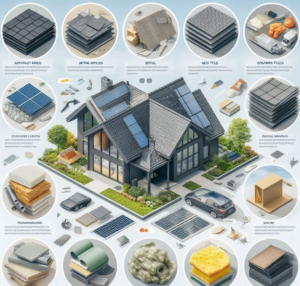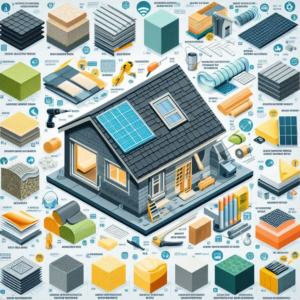 Being the foremost guard against environmental elements, the significance of possessing a sturdy and well-kept roof over your head is prominent. Its chief function includes providing primary protection against a series of environmental attackers, including heavy rain, hailstorms, strong wind pressures, and intense heat. A superior quality roofing system won’t just only deter these harsh factors but also play a vital role in enhancing the home’s overall energy effectiveness.
Being the foremost guard against environmental elements, the significance of possessing a sturdy and well-kept roof over your head is prominent. Its chief function includes providing primary protection against a series of environmental attackers, including heavy rain, hailstorms, strong wind pressures, and intense heat. A superior quality roofing system won’t just only deter these harsh factors but also play a vital role in enhancing the home’s overall energy effectiveness.
Numerous features cause an enhancement in the roofing system’s efficiency; however, one aspect that necessitates a notable mention is the selection of materials. Opting for reflective roofing materials results in the deflection of part of the sun’s harsh rays, subsequently lessening the amount of heat a building absorbs. Metals roofs serve as an apt instance in this regard. Bestowed with the quality of offering enduring durability, metal roofs also possess the ability to maintain building temperatures on the cooler side.
On the other hand, roofs made up of tile and slate, despite being on the heavier side of the material spectrum, are known for their exceptional resistance and longevity. These materials play a significant role in maintaining uniformity in indoor temperatures, contributing positively to the building’s overall energy efficiency.
The role of regular maintenance in preserving the protective efficiency of the roof is crucial. Like any other element exposed to external environmental factors, roofs too go through a comprehensive wear and tear process with time. Conducting periodic inspections enables early identification of potential issues, such as shingles showing signs of cracks or damage in the flashing, and ensures they are dealt with before they escalate into major concerns. Swift management of such small repairs by homeowners not only saves them from considerable future issues but also aids in extending the lifespan of their roofs while preserving their effectiveness.
Roof Insulation – A Critical Energy Saver
Insulating the roof of a property can be seen as one of the most productive methods of improving the energy efficiency of a home. Loss of heat through an uninsulated roof can be substantial when the weather is cold, and the same roof will admit unwelcome heat in warmer times, resulting in elevated energy expenditures. The correct insulation can facilitate a uniform temperature within a dwelling, lessening reliance on the overuse of heating or cooling systems.
A range of insulation materials is available on the market, with each having unique advantages to offer. Amongst these, fiberglass insulation is often chosen due to the balance it strikes between cost and easy application. On the other hand, foam board insulation, boasting notable thermal resistance, is a favored option for external usage underneath the actual roofing components. Spray foam insulation, known for its superior capability to fill gaps and spaces, is a top pick when dealing with awkwardly shaped or difficult-to-access areas.
The process of installing roof insulation calls for several essential considerations. The thickness of the insulation and its R-value – indicative of the material’s thermal resistance, are vital elements that can impact its effectiveness. Insulation with a higher R-value displays improved insulation properties, which can significantly enhance a building’s overall energy efficiency.
Adhering to the stipulations of local building codes is an absolute necessity. These ordinances mandate the minimum insulation R-values for roofs and attics, taking into account the specific climate conditions of the region. This ensures that all buildings will have some level of thermal resistance suitable for the typical weather patterns of the area.
Investing in quality roof insulation can yield long-term savings. While the initial costs may seem substantial, homeowners can expect to benefit from lower energy bills, making the investment in roof insulation a cost-effective strategy in the long haul. Therefore, while the notion of roof insulation might initially seem merely like an additional expenditure, considering the energy savings and increased comfort it provides, it becomes evident that it is a resourceful solution, integral to any energy-efficient home.
Sealing and Ventilation
 Achieving a well-insulated home goes beyond the exclusion of external temperatures; it encompasses airflow management to avoid moisture buildup and maintain quality indoor air. Sealing leaks and providing proper ventilation are critical for the effectiveness of a roofing and insulation system.
Achieving a well-insulated home goes beyond the exclusion of external temperatures; it encompasses airflow management to avoid moisture buildup and maintain quality indoor air. Sealing leaks and providing proper ventilation are critical for the effectiveness of a roofing and insulation system.
Homeowners must address cracks and openings around roof features, such as vents and chimneys, to curb the loss of warm or cool air. Implementing weatherstripping and caulking are straightforward solutions for sealing these spots. Conversely, ensuring sufficient ventilation is key to obstructing moisture accumulation that could cause mold, mildew, or even structural damage as time progresses. Attic ventilation systems designed with precision permit the flow of outside air through the attic, substantially diminishing the possibility of moisture issues and aiding temperature regulation.
Insulation and ventilation must be delicately balanced to optimize roofing efficiency. Insulation preserves desired temperatures indoors, while ventilation counteracts the concentration of hot or humid air in the attic that might impair the insulation’s performance. Attaining this equilibrium contributes positively to a comfortable and efficient home atmosphere across the seasons.
An all-encompassing strategy in roofing and home insulation is crucial for a comfortable and enduring living space. Committing to high-quality roofing materials, sustaining roof integrity, implementing adequate insulation, and employing effective sealing and ventilation tactics enables homeowners to secure a cozy and energy-conscious home that stands resilient against time and weather.